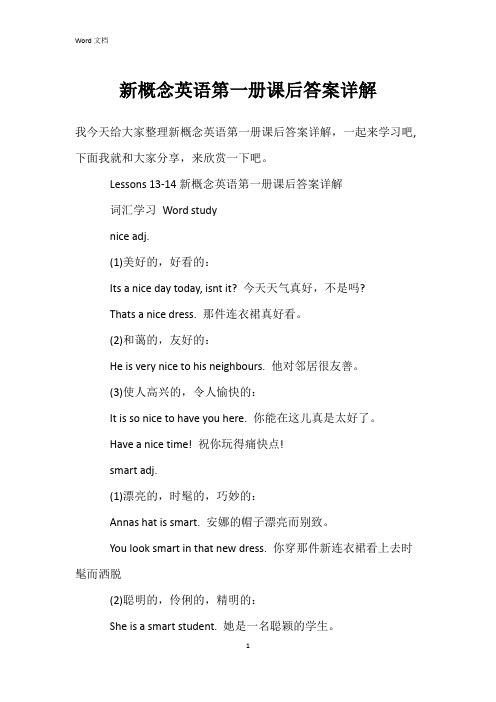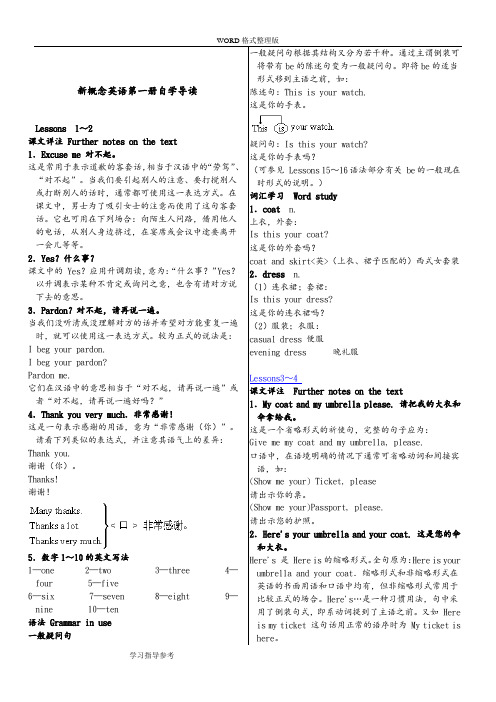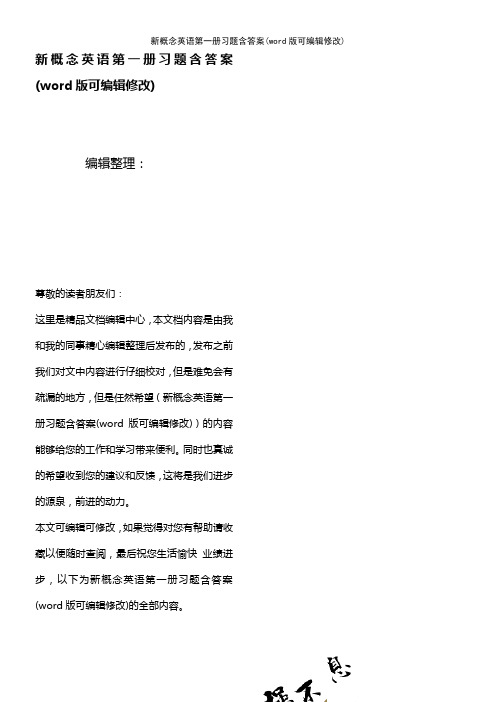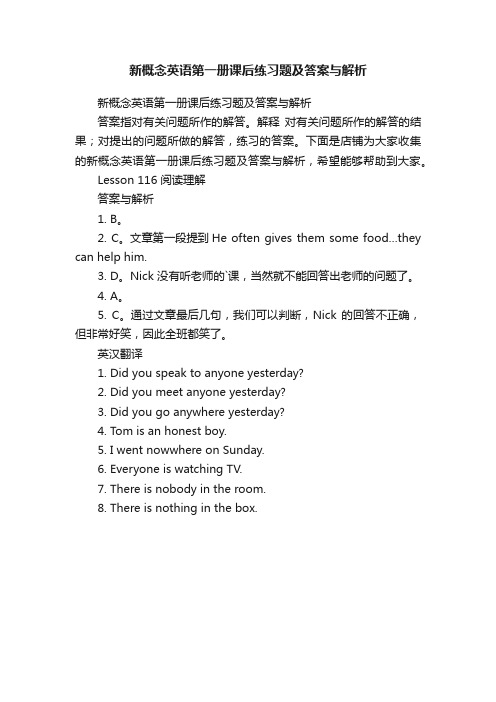新概念第一册自学导读,习题答案
新概念英语第一册自学导读Lesson 9 How are you today?

新概念英语第一册自学导读Lesson 9 How are youtoday?自学导读1.How are you today?你今天好吗?这是朋友或相识的人之间见面时问对方身体情况的寒暄话,一般回答语为:Fine, thank you.很好,谢谢。
I'm fine, thank you.很好,谢谢。
I'm very well, thank you.很好,谢谢。
如问及对方的先生或太太的情况,能够说 How is Tony?或How's Emma?等。
相对应的回答可为 He's fine,thanks 或 She's very well,thankyou等。
2.And you?你好吗?是And how are you?的简略说法。
在回答对方问候健康的话之后反问时用。
3.数字21与22的英文写法21-twenty-one 22-twenty-two语法 Grammar in use1.How…?的一些社交上的用法how 是一个表示"如何"的疑问词,能够用来引导一些用于社交场合的套话:(1)用于询问健康状况或一般生活情况:How are you?你好吗?How is Helen today?海伦今天好吗?How have you been?你一向可好?(2)How do you do?(你好吗?)是正式介绍中的一句套话,从不用来询问健康:(3)how 经常用在询问当前状况的疑问句里,如:How's life?生活如何?How are things?情况怎样?How's work?工作怎么样?2.形容词的意义与作用(1)形容词修饰名词所指的人、物等。
我们用形容词说明人、物等是什么样或看上去是什么样的。
例如,形容词能够表示质量、大小、新旧、温度、形状、颜色、产地。
(2)很多形容词可用以回答What…like?这样的问题,并可根据上下文给出笼统的或确切的信息。
新概念英语第一册自学导读 Lessons53-54

新概念英语第一册自学导读 Lessons53-54课文详注 Further notes on the text1.in the North=in the north of England.North的首字母大写,是因为它单独使用,特指英国的北部。
表示一个国家或地区的方位词一般要大写。
本课中的方位词均表示国家的一部分:in the East 在东部in the West 在西方in the South 在南方但是,仅仅表示方位意义的方位词不需大写。
如:a north wind 北风a south window 南窗2.Which seasons do you like best? 你最喜欢哪些季节?句中的best是副词well的级,作状语,修饰like。
3.The sun rises early and sets late. 太阳升得早而落得晚。
句中的early和late都是副词,分别修饰动词rises和sets,作状语。
注意the sun中定冠词的用法。
在英语中,表示世界上独一无二的东西(如太阳、月亮、世界、地球、天空、宇宙)的名词之前通常需加定冠词。
4.favourite subject of conversation, 最喜欢谈论的话题。
英国人见面时谈话通常是从天气开始的。
一方面这与英国的自然地理情况相关,另一方面则与英国人的民族性格相关。
谈论天气是任何人都可接受的话题,而且这可避免介入令人尴尬的或侵入私人领域的话题。
语法 Grammar in uselike (v.)与like (prep.)like(v.)表示“喜欢”、“想要”(请参见 Lessons 47~48词汇部分),而like(prep.) 表示“像……一样”:His car is like mine.他的汽车跟我的那辆一样。
She is very like her sister.她和她姐姐相像极了。
The new building looks like a big bird.那座新建筑看上去像是一只大鸟。
新概念英语第一册课后答案详解

新概念英语第一册课后答案详解我今天给大家整理新概念英语第一册课后答案详解,一起来学习吧,下面我就和大家分享,来欣赏一下吧。
Lessons 13-14新概念英语第一册课后答案详解词汇学习Word studynice adj.(1)美好的,好看的:Its a nice day today, isnt it? 今天天气真好,不是吗?Thats a nice dress. 那件连衣裙真好看。
(2)和蔼的,友好的:He is very nice to his neighbours. 他对邻居很友善。
(3)使人高兴的,令人愉快的:It is so nice to have you here. 你能在这儿真是太好了。
Have a nice time! 祝你玩得痛快点!smart adj.(1)漂亮的,时髦的,巧妙的:Annas hat is smart. 安娜的帽子漂亮而别致。
You look smart in that new dress. 你穿那件新连衣裙看上去时髦而洒脱(2)聪明的,伶俐的,精明的:She is a smart student. 她是一名聪颖的学生。
He is a smart businessman. 他是一位精明的商人。
练习答案Key to written exercisesLesson 14A1 This is Pauls car.2 This is Sophies coat.3 This is Helens dog.4 This is my fathers suit.5 This is my daughters dress.B1 What colours Stevens car? His cars blue.2 What colours Tims shirt? His shirts white.3 What colours Sophie s coat? Her coats grey.4 What colours Mrs. Whites carpet? Her carpets red.5 What colours Daves tie? His ties orange.6 What colours Stevens hat? His hat is grey and black.7 What colours Helens dog? Her dogs brown and white.8 What colours Hans pen? His pens green.9 What colours Lumings suit? His suits grey.10 What colours Stellas pencil? Her pencils blue.11 What colours Xiaohuis handbag? Her handbags brown.12 What colours Sophie s skirt? Her skirts yellow.Lessons 23-24新概念英语第一册课后答案详解词汇学习Word studydesk与table在汉语中,这两个词都被称为“桌子”,而在英语中,它们仍是有所区别的。
新概念第一册自学导读,习题答案

新概念第一册自学导读,习题答案自学新概念英语第一册87-88课自学笔记,包括87-88课的课文重难点详解、语法知识点、重点单词学习和88课的课后练习答案。
新概念英语第一册87-88课课文知识点 Further notes on the text1.When did you bring it to us? 您什么时候送来的?bring表示“送来”、“带来”和“拿来”的意思,在方位上多指朝说话人而来。
2.…they're still working on it. ……他们还在修呢。
work on 表示“从事”、“干”(某事)。
still是“仍然”、“还在”的意思,此处在句中对 working on it起了强调的作用。
3.have a look at it, 看一下。
这里的 it指 car,以防止重复。
这里的 look是名词,have a look at与 look at意思是一样的。
4.Isn't that your car? 这难道不是您的车吗?Didn't you have a crash? 难道您没有出车祸吗?在英文中可以用一般疑问句的否认形式来表示期待、请求或希望得到肯定的答复。
新概念英语第一册87-88课语法知识点 Grammar in use现在完成时的疑问式及否认式现在完成时的构成是 have/has+ 过去分词,因此其疑问式是将have/has提到主语之前,否认式那么在have/has后加上not即可。
新概念英语第一册87-88课词汇学习 Word study1.repair v.(1)修理;修复;修补:I'll have to get the bicycle repaired. 我得请人把自行车修理一下。
She looked into the mirror and began to repair her face. 她向镜中望去,开始往脸上重敷脂粉。
(完整版)新概念英语第一册自学导读

新概念英语第一册自学导读Lessons 1~2课文详注 Further notes on the text.Excuse me 对不起。
这是常用于表示道歉的客套话,相当于汉语中的“劳驾”、“对不起”。
当我们要引起别人的注意、要打搅别人或打断别人的话时,通常都可使用这一表达方式。
在课文中,男士为了吸引女士的注意而使用了这句客套话。
它也可用在下列场合:向陌生人问路,借用他人的电话,从别人身边挤过,在宴席或会议中途要离开一会儿等等。
.Yes?什么事?课文中的 Yes?应用升调朗读,意为:“什么事?”Yes?以升调表示某种不肯定或询问之意,也含有请对方说下去的意思。
.Pardon?对不起,请再说一遍。
当我们没听清或没理解对方的话并希望对方能重复一遍时,就可以使用这一表达方式。
较为正式的说法是:I beg your pardon.I beg your pardon?Pardon me.它们在汉语中的意思相当于“对不起,请再说一遍”或者“对不起,请再说一遍好吗?”.Thank you very much.非常感谢!这是一句表示感谢的用语,意为“非常感谢(你)”。
请看下列类似的表达式,并注意其语气上的差异:Thank you.谢谢(你)。
Thanks!谢谢!.数字1~10的英文写法—one 2—two 3—three 4—four 5—five—six 7—seven 8—eight 9—nine 10—ten语法 Grammar in use一般疑问句一般疑问句根据其结构又分为若干种。
通过主谓倒装可将带有be的陈述句变为一般疑问句。
即将be的适当形式移到主语之前,如:陈述句:This is your watch.这是你的手表。
疑问句:Is this your watch?这是你的手表吗?(可参见 Lessons 15~16语法部分有关 be的一般现在时形式的说明。
)词汇学习 Word study1.coat n.上衣,外套:Is this your coat?这是你的外套吗?coat and skirt<英>(上衣、裙子匹配的)西式女套装2.dress n.(1)连衣裙;套裙:Is this your dress?这是你的连衣裙吗?(2)服装;衣服:casual dress 便服evening dress 晚礼服Lessons3~4课文详注 Further notes on the text1.My coat and my umbrella please. 请把我的大衣和伞拿给我。
新概念英语第一册习题含答案(K12教育文档)

新概念英语第一册习题含答案(word版可编辑修改) 新概念英语第一册习题含答案(word版可编辑修改)编辑整理:尊敬的读者朋友们:这里是精品文档编辑中心,本文档内容是由我和我的同事精心编辑整理后发布的,发布之前我们对文中内容进行仔细校对,但是难免会有疏漏的地方,但是任然希望(新概念英语第一册习题含答案(word版可编辑修改))的内容能够给您的工作和学习带来便利。
同时也真诚的希望收到您的建议和反馈,这将是我们进步的源泉,前进的动力。
本文可编辑可修改,如果觉得对您有帮助请收藏以便随时查阅,最后祝您生活愉快业绩进步,以下为新概念英语第一册习题含答案(word版可编辑修改)的全部内容。
新概念英语第一册习题 Lesson 1A About youCopy this dialogue。
Add your own name at the end。
抄写这段对话,。
在结尾处加上你的名字.Sue: Excuse me。
______John: Yes? ______Sue: What's your name? ______John: Pardon? ______Sue: What's your name? ______John: My name is John。
______ Sue: What’s your name? ______You: My name is。
..... ______B VocabularyWrite the correct words in the questions.。
用正确的词完成以下问句。
book car coat dress house√。
pen pencil shirt wathc1 Is this your h______? 6 Is this your c______?2 Is this your w______? 7 Is this your c______?3 Is this your sh ______? 8 Is this your d______?4 Is this your b______? 9 Is this your p______?5 Is this your p______? 10 Is this your s ______?C NumbersWrite the numbers in figures.. 用阿拉伯数字表示以下数词. three 3 ten______ one______ four______ six______five______eight_________ seven______ two______nine______Lesson 1B2 watch3 shirt4 book5 pen6 coat7 car8 dress9 pencil 10 skirtC10,1,4,6,5,8,7,2,9新概念英语第一册习题 Lesson 2Lesson 2 Is this your。
新概念英语第一册课后练习题及答案与解析

新概念英语第一册课后练习题及答案与解析
新概念英语第一册课后练习题及答案与解析
答案指对有关问题所作的解答。
解释对有关问题所作的解答的结果;对提出的问题所做的解答,练习的答案。
下面是店铺为大家收集的新概念英语第一册课后练习题及答案与解析,希望能够帮助到大家。
Lesson 116 阅读理解
答案与解析
1. B。
2. C。
文章第一段提到He often gives them some food…they can help him.
3. D。
Nick 没有听老师的`课,当然就不能回答出老师的问题了。
4. A。
5. C。
通过文章最后几句,我们可以判断,Nick 的回答不正确,但非常好笑,因此全班都笑了。
英汉翻译
1. Did you speak to anyone yesterday?
2. Did you meet anyone yesterday?
3. Did you go anywhere yesterday?
4. Tom is an honest boy.
5. I went nowwhere on Sunday.
6. Everyone is watching TV.
7. There is nobody in the room.
8. There is nothing in the box.。
新概念英语第一册自学导读Lesson 137 A pleasant dream

新概念英语第一册自学导读Lesson 137 A pleasantdream自学导读1.do the football pools,下足球赛的赌注。
football pools 是英国流行的一种赌博方式,靠在足球比赛结果上的赌注来决定输赢。
2.What will you do if you win a lot of money?如果你赢了很多钱,你打算做什么呢?if you win a lot of money是一个表示条件的状语从句。
在英文中,条件是指某一事情(状语从句中的动作)实现之后其他事情(主句中的动作)才能发生,通常译为“假如”。
如果条件状语从句用于询问或谈论十分可能发生的事情,那么条件状语从句中常用一般现在时,而主句中则用一般将来时。
a lot of既可与可数名词也可与不可数名词连用。
(请参见本课语法部分。
)3.buy sb. sth.= buy sth.sb.。
4.see the world,看世界。
travel round the world,周游世界。
二者有异曲同工之处。
5. What'll we do then?那时我们怎么办呢?句中then意为“到那时”(指将来)。
6.a pleasant dream,一个美好的梦。
7.depend on,取决于,依靠。
语法 Grammar in use第1类条件句如果我们认为将来的事件是可能发生的,就可用第1类条件句去描述将会发生什么事或不会发生什么事。
其基本结构是:If +一般现在时+将来时(或情态助动词),如:If it rains tomorrow, we won't go to the seaside.如果明天下雨,我们就不去海边。
if从句中的现在时表示需具备的条件,主句中的shall/will将来时表示可能的结果。
具备的条件是真实的,可能真的下雨。
如果是这样,它就会有真实的结果。
这就是为什么这样的陈述句常被称为“开放”条件句或“真实”条件句的原因。
- 1、下载文档前请自行甄别文档内容的完整性,平台不提供额外的编辑、内容补充、找答案等附加服务。
- 2、"仅部分预览"的文档,不可在线预览部分如存在完整性等问题,可反馈申请退款(可完整预览的文档不适用该条件!)。
- 3、如文档侵犯您的权益,请联系客服反馈,我们会尽快为您处理(人工客服工作时间:9:00-18:30)。
新概念第一册自学导读,习题答案篇一:新概念英语第一册自学导读:Lesson 87-88的自学笔记含课后练习答案自学新概念英语第一册87-88课自学笔记,包括87-88课的课文重难点详解、语法知识点、重点单词学习和88课的课后练习答案。
新概念英语第一册87-88课课文知识点 Further notes on the text 1.When did you bring it to us? 您什么时候送来的? bring表示“送来”、“带来”和“拿来”的意思,在方位上多指朝说话人而来。
2.…they re still wo rking on it. ……他们还在修呢。
work on 表示“从事”、“干”(某事)。
still是“仍然”、“还在”的意思,此处在句中对 working on it起了强调的作用。
3.have a look at it, 看一下。
这里的 it指 car,以避免重复。
这里的 look是名词,have a look at 与 look at意思是一样的。
4.Isn t that your car? 这难道不是您的车吗?Didn t you have a crash? 难道您没有出车祸吗?在英文中可以用一般疑问句的否定形式来表示期待、请求或希望得到肯定的答复。
新概念英语第一册87-88课语法知识点 Grammar in use 现在完成时的疑问式及否定式现在完成时的构成是 have/has+ 过去分词,因此其疑问式是将have/has提到主语之前,否定式则在have/has后加上not即可。
新概念英语第一册87-88课词汇学习 Word study 1.repair v. (1)修理;修复;修补: I ll have to get the bicycle repaired. 我得请人把自行车修理一下。
She looked into the mirror and began to repair her face. 她向镜中望去,开始往脸上重敷脂粉。
(2)弥补;修复;赔偿: How can I repair the mistake I have made? 我如何才能弥补我所犯的错误呢? It will take a while to repair the confidence of the general public. 要恢复公众的信心尚需要一些时间。
2.try v.(1)试图;设法,努力: They tried hard to repair the damaged car. 他们竭尽全力修理那辆被损坏了的汽车。
He is trying to move the book shelf. 他正试图搬动那个书架。
(2)尝试,试用;试验: She s trying her new car. 她正在试她的新车。
I ll try that Italian restaurant next time. 下次我要到那家意大利餐馆去尝尝他们的菜。
新概念英语第一册88课课后练习答案 Key to written exercises Lesson 88 A 1 Did he find his pen a minute ago? He didn t find his pen a minute ago. 2 Did he get a new television last week? He didnt get a new television last week. 3 Did you hear the news on the radio? We didn t hear the news on the radio. 4 Did they leave this morning? They didn t leave this morning. 5 Did he lose his umbrella yesterday? He didn t lose his umbrella yesterday. 6 Did you sweep the floor this morning?I didn t sweep the floor this morning. B 1 Has he met Mrs. Jones yet? Yes, he has already met Mrs. Jones. When did he meet Mrs. Jones? He met her two weeks ago. 2 Has the boss left yet?Yes, the boss has already left. When did the boss leave? He left ten minutes ago. 3 Has he had breakfast yet? Yes, he has already had breakfast. When did he have breakfast? He had breakfast at half past seven. 4 Has she found her pen yet? Yes, she has already found her pen. When did she find her pen? She found her pen an hour ago. 5 Has he got a television yet? Yes, he has already got a television. When did he get a television? He got a television two weeks ago. 6 Has she heard the news yet? Yes, she has already heard the news. When did she hear the news? She heard the news yesterday. 7 Has she made the bed yet? Yes, she has already made the bed. When did she make the bed? She made the bed this morning. 8 Has he sent the letter yet? Yes, he has already sent the letter. When did he send the letter? He sent the letter the day before yesterday9 Has she swept the floor yet? Yes, she has already swept the floor. When did she sweep the floor? She swept the floor yesterday morning. 10 Has she told him the truth yet? Yes, she has already told him the truth. When did she tell him the truth?She told him the truth last night.篇二:新概念第一册自学导读新概念第一册自学导读 (含答案) --不完整,遗漏部分内容 Lessons1-2 Lessons1-2 课文详注 Further notes on the text 1.Excuse me 对不起。
这是常用于表示道歉的客套话,相当于汉语中的“劳驾”、“对不起”。
当我们要引起别人的注意、要打搅别人或打断别人的话时,通常都可使用这一表达方式。
在课文中,男士为了吸引女士的注意而使用了这句客套话。
它也可用在下列场合:向陌生人问路,借用他人的电话,从别人身边挤过,在宴席或会议中途要离开一会儿等等。
2.Yes?什么事?课文中的Yes?应用升调朗读,意为:“什么事?”Yes?以升调表示某种不肯定或询问之意,也含有请对方说下去的意思。
3.Pardon?对不起,请再说一遍。
当我们没听清或没理解对方的话并希望对方能重复一遍时,就可以使用这一表达方式。
较为正式的说法是: I beg your pardon. I beg your pardon? Pardon me. 它们在汉语中的意思相当于“对不起,请再说一遍”或者“对不起,请再说一遍好吗?” 4.Thank you very much.非常感谢!这是一句表示感谢的用语,意为“非常感谢(你)”。
请看下列类似的表达式,并注意其语气上的差异: Thank you. 谢谢(你)。
Thanks! 谢谢! 5.数字1~10的英文写法 1—one 2—two 3—three 4—four 5—five 6—six 7—seven 8—eight 9—nine 10—ten 语法Grammar in use 一般疑问句一般疑问句根据其结构又分为若干种。
通过主谓倒装可将带有be的陈述句变为一般疑问句。
即将be的适当形式移到主语之前,如:陈述句:This is your watch. 这是你的手表。
疑问句:Is this your watch? 这是你的手表吗?(可参见 Lessons 15~16语法部分有关 be的一般现在时形式的说明。
)词汇学习 Word study 1.coat n. 上衣,外套: Is this your coat? 这是你的外套吗? coat and skirt 英(上衣、裙子匹配的)西式女套装 2.dress n.(1)连衣裙;套裙: Is this your dress? 这是你的连衣裙吗?(2)服装;衣服: casual dress 便服 evening dress晚礼服 ||| ||||||| ? Lessons3-4 Lessons3-4 课文详注 Further notes on the text 1.My coat and my umbrella please. 请把我的大衣和伞拿给我。
这是一个省略形式的祈使句,完整的句子应为: Give me my coat and my umbrella, please. 口语中,在语境明确的情况下通常可省略动词和间接宾语,如: (Show me your) Ticket, please 请出示你的票。
(Show me your)Passport, please. 请出示您的护照。
2.Here s your umbrella and your coat. 这是您的伞和大衣。
